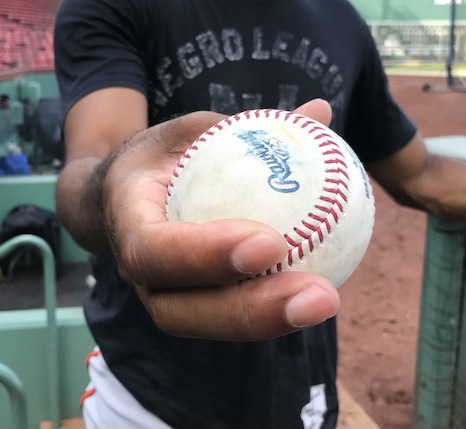Dillon Tate Talks Fastballs
Dillon Tate’s fastballs were primarily sinkers this season. Per Statcast, the 27-year-old Baltimore Orioles reliever threw 615 of them in total, versus just 16 four-seamers. Delivered with a one-seam grip at an average velocity of 95.5 mph, and with a spin rate that ranked in the third percentile, the offering has evolved into Tate’s signature pitch. Buoyed by its increased effectiveness, the right-hander appeared in a career-high 62 games, logging a 4.39 ERA and an almost-identical 4.40 FIP.
Tate discussed the evolution of his fastball(s) when the Orioles played at Fenway Park in mid-September.
———
Dillon Tate: “I’d always thrown a four-seam, but the evolution of my fastball changed throughout the years. When I was in high school, I would grip a standard four-seam, like so. But the way I was grabbing it… when you grab it with the horseshoe facing in — it’s making a “C” — and you throw it, the Magnus effect takes over; it will start to bring the ball down, and more so in to a right-handed hitter. When you flip it over — make it a backwards “C” — it fights gravity a little bit more, so will stay truer. I learned that in 2017 from one of my rehab coaches with the Yankees, Greg Pavlick.

“So, I’d been grabbing it [with the horseshoe facing in], and then with the Yankees switched over. I had a little bit of success, but then towards the middle-end of 2018, my fastball was getting hit pretty hard. That’s when I started switching over to a sinker, to a one-seam fastball. On a traditional two-seam fastball, a lot of guys will split the seams. I found comfort in going across the seam, and throwing my fastball with [the pointer finger] on one seam. I started to see my groundball rate go up. It’s turned out to be pretty good movement profile-wise — it dances more than my four-seam fastball did — so it’s been a better option for me.

“I actually started throwing [the one-seam] in a game. I was in Double-A, and we were playing the Yard Goats, in Hartford. Again, this was in 2018. I got hit pretty hard in the first sitting, and I came back the next inning and said, ‘OK, I’m throwing this.’ Nobody hit the ball in the air the rest of the game.
“[Inverting the C] had actually helped, but the four-seam isn’t the greatest pitch for me in general, because my arm slot is kind of across a little bit. When I do that, it takes the axis of the ball to where it will start tilting, like so. That’s why the Yankees came up to me and said, ‘You know, we want you to work on a two-seam fastball.’ So I gradually started dabbling with that, although I didn’t figure it out until after I’d left [the organization].
“A one-seam just felt more comfortable for me. When I was throwing a two-seam, it kept cutting, and I kept throwing it in the dirt. It was ending up everywhere but in the strike zone. I decided to bounce some grips off of certain guys’ heads, and a guy I’m pretty cool with — he’s playing for the Mets now — is Stephen Tarpley. He showed me the one-seam, and and it felt good in my hand. I was like, ‘I have an idea of where this is going,‘ so I ran with it.
“I’m still kind of figuring out how [firmly] I want to grip it. I’ve been messing around with that recently, figuring out if I’m a guy that’s going to grip it really hard, or if I’m going to relax and grip it a little bit more loosely to let the ball just kind of roll off of my fingers, as opposed to having more friction and tension on it.
“Rapsodo doesn’t pick up my fastball very well. I don’t know if you’re familiar with seam-shifted wake, but my fastball has that and Rapsodo doesn’t pick it up. I need TrackMan to pick up my sinker. Rapsodo will tell me that I’m throwing my sinker at 1:45, or 1:30, but in reality it’s spinning and then, as it’s getting to the plate, changing its axis. From what someone told me, the seams are repeating themselves. I’m not entirely sure about the definitions — if that’s seam-shifted wake — but I know that my fastball has that property.
“I’ve never been a high-spin guy. With the four-seam, at the very best my fastball will probably spin at 2,200 [rpm]. When I went to [the one-seam], I found that it’s spinning anywhere from 1,700 to 2,000. The spin is pretty low.
“To the naked eye… when somebody is seeing it on TV, they just think that it has a lot of run. Which it does; my sinker is running. There isn’t a lot of vertical on my fastball, but it is going down. It’s not something that the viewer is going to to see, but the batter will notice it. When he starts his swing… if I’m throwing it in a desirable location, the batter is going to hit the top of the ball. It’s going down, but it’s very, very late. It’s tough to see that on TV.”
David Laurila grew up in Michigan's Upper Peninsula and now writes about baseball from his home in Cambridge, Mass. He authored the Prospectus Q&A series at Baseball Prospectus from December 2006-May 2011 before being claimed off waivers by FanGraphs. He can be followed on Twitter @DavidLaurilaQA.
Tate sounds like he has a good idea of what he’s doing out there. I did find it a little curious that he’s still figuring out how tightly to grip his 1-seamer. I’ve heard of guys tightening a slider grip to cut the ball more and throw it firmer, but not necessarily experimentally. Hopefully its something he can get comfortable with in the offseason.